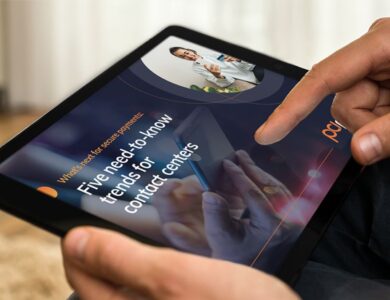Our lives are increasingly digital—buying goods, booking holidays, attending classes, working, speaking to friends and so on.
And, thanks to the connectivity our smartphones enable, we live our digital lives on the go. In fact, half of customers will stop using a company’s website if it isn’t mobile-friendly, even if they like the business.
Contact centers are no exception, 41 percent of consumers now prefer live chat support to speaking to an agent on the phone.
With such an emphasis on the digital experience, how can contact centers avoid losing sight of maintaining non-digital options?
Our lives aren’t digital-only
It’s important not to get too swept up in the digital tide.
Customers still want to be able to speak to agents on the phone, particularly if they’re making a large or complicated payment. In those instances, 87% of customers find it reassuring to speak to an agent on the phone. And one-third of over 65s simply aren’t comfortable making payments online.
So, if you’ve created a digital-only contact center, those customers will feel unsupported and go elsewhere.
But even when customers want to speak to agents, it should still be frictionless, especially considering half of customers will hang up if they’re placed on hold for up to 10 minutes.
But they are digital-first
Of course, contact centers mustn’t forget digital-first experiences. This means enabling customers to choose which channel they use and ensuring that conversations flow seamlessly across platforms. So, if a customer starts a conversation on a web chat, it can easily be progressed onto a phone call if needed.
The process of taking a payment needs to be just as smooth. Instead of keying in card details, some customers want to pay using Click to Pay—a digital link where payment can be completed in seconds via Apple Pay or Google Pay. Or using online chat, enabled by conversational AI providers like Converse360 to automate the payment process.
These frictionless payment options have multiple benefits for customers and the contact center agents—customers experience shorter wait times and agents have lighter workloads.
With nine out of ten customers using a digital form of payment each year, it really is a no-brainer. And the companies that are digital-first are much more likely to be able to quickly adopt new technologies and capture customers frustrated with less technically advanced companies.
Take inspiration from banks
Striking the balance between digital and non-digital experiences is possible.
The banking industry is an example of it in practice. Despite the increasing popularity of digital banking—over a third of customers prefer using a banking app to any other option—two thirds of customers still visit their local branch if they need help with a more complex problem.
Banks have recognized that the rise of digital banking doesn’t mean the end of bricks-and-mortar banking, in fact JP Morgan is even building 500 new Chase branches. And Capital One Cafés offer a space for customers and non-customers to seek help from the Café Ambassadors or simply enjoy the cafe.
Banks are meeting customer expectations for fast, seamless and modern transactions by offering omni-channel experiences.
The future is omni-channel
The world isn’t digital-only so why would your contact center be? Instead, to truly align with customer expectations and preferences, contact centers need to offer omni-channel experiences across the customer journey.
That means offering customers the ability to choose the payment option that best meets their needs—whether Speak to Pay, Click to Pay or Key to Pay. And ensuring that whichever option they choose, it is seamless and fast, consistent and frictionless, without compromising customer experience or security.
While all contact centers will benefit from accelerating their digital-first approach, those that provide a true omni-channel experience will stand out. Those are the contact centers that will be best placed to adapt to customers’ changing expectations and the rise of new technologies.













